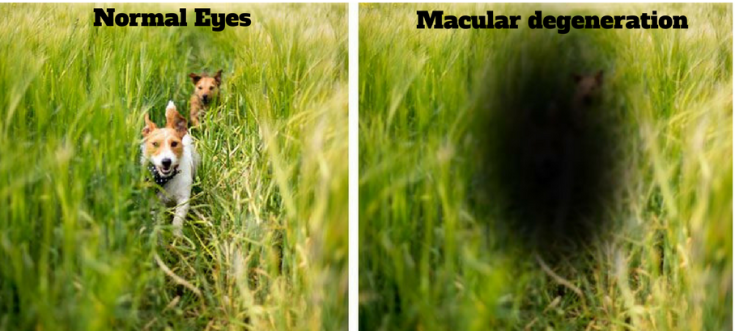Age-related Macular Disease, which is also known as AMD, is an eye disease that commonly occurs among the elderly where the macula deteriorates and leads to central vision loss over time.
AMD will not cause complete blindness because it does not affect the side vision. However, since macula determines our ability to read, recognize faces, driving and other visual activities, significantly AMD will significantly affect the quality of our life.

There are two types of AMD, dry AMD (early stage) and wet AMD (advanced stage). Person with AMD will lose their ability to see things clearly, difficulty in recognizing face and color, distortion of vision and dark area in centre of vision.
There are many factors that can increase the risk of developing AMD. Unfortunately, there are some factors that we cannot control such as age, genes and sex. Although AMD is associated with aging, there is research which shows that genes plays a role to the disease too. AMD is more common in women.
Based on the British Journal of Ophthalmology, it is found out that smokers have double the risk of developing AMD. Furthermore, patients who have obesity tend to have double the risk of developing advanced forms of AMD. Person with high blood pressure is associated with higher chance of developing AMD.
Early signs of AMD might go unnoticed,
therefore regular eye examination is critical for preventing vision loss. Doctor can diagnose AMD early before vision loss occurs.
# Prevention
Researcher has advised us to quit smoking in order to prevent AMD. Reduce exposure to UV light or avoid from looking at the sun directly with naked eyes. UV light can harm our eyes, so wear sunglasses that are UV protected.
By consuming supplements that contains ingredients studied in Age-Related Eye Disease Study 2 (AREDS2) can reduce the rate of advanced AMD in people at high risk by about 25 percent.
AREDS2 is a major clinical trial that conducted by the National Eye Institute of America, studying the effects of oral supplementation of high doses of lutein, zeaxanthin and/or omega -3 LCPUFAs (DHA and EPA) for the treatment of AMD and cataract.
About 90% of patients are found to have dry AMD.
It is a slowly progressive thinning of macula and causes our vision to become gradually blurry.
Wet AMD is less common but it is more dangerous. It can develop rapidly and cause severe vision loss. Wet AMD is causes by rupture of weak blood vessels, bleeding into eye. The bleeding will result in vision loss due to the scar that left by the bleeding. This can be treated medically by using laser and drugs, sealing leaking blood vessels and prevent scarring.


Leave a comment